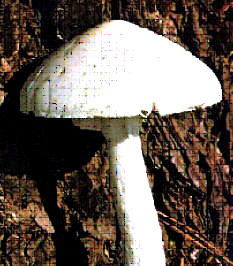|
 About
Fungi About
Fungi
What are fungi?
For non-science types, we'll
break down the definition word by word. "they
are eucaryotic, heterotrophic and
absorptive..."
a: Eucaryotic
b: Heterotrophic
c: Absorptive
Are fungi plants?
How
are fungi important to the environment?
What are some
uses of fungi?
What are mycologists?

What are
fungi?
A
formal definition of fungi would include that they are
eukaryotic,
heterotrophic and
absorptive organisms, which have cell walls,
typically reproduce asexually and/or sexually by
producing spores, and grow either reproductively by
budding or nonreproductively by hyphal tip elongation.
What does that mean?
For
non-science types, we'll break down the definition
word by word. "they are eukaryotic,
heterotrophic and absorptive..."
a: Eukaryotic
All living things are made
from cells. Although there are many kinds of
cells, the most broad difference between any two cells
is whether they are eukaryotic or prokaryotic.
Eukaryotic refers
specifically to cells that
contain a well defined nucleus. Eukaryotes
(having cells that are eukaryotic) are also typically larger,
contain membrane-bound structures
(organelles), divide
their chromosome complement by mitosis
and/or meiosis, and usually have a sexual life cycle.
Animals, plants, and fungi are eukaryotic.
Prokaryotes (having cells that are prokaryotic) are usually
smaller than eukaryotes, not compartmentalized
by having organelles, and do
not have a membrane-bound nucleus. Bacteria are prokaryotic.
b:
Heterotrophic
Heterotrophic organisms require nutrients that
have been preprocessed by other life forms - in
contrast to autotrophic organisms, which are able
to make their own food from simple molecules. Animals
(including humans) and fungi are all heterotrophs.
Nearly all plants (with the exception of carnivorous
and some parasitic plants) are autotrophic -- they only require
water, carbon dioxide, light and mineral nutrients to
thrive.
c: Absorptive
Fungi obtain
food by taking it up with water and other dissolved substances
across an outer membrane that is located directly
inside their cell wall; they are not phagocytic or
ingestive.
(Back to
the top)

Are fungi plants?
No!...There are currently a minimum of five
kingdoms of life, with most modern biologists suggesting many
more. Fungi belong to Kingdom Fungi
while plants belong to Kingdom Plantae.
Fungi are not plants. They are plant-like
organisms that lack chlorophyll and absorb food from
their many habitats. They don't require sunlight for their
growth, so fungi can live in dark places.
Fungal Nutrition -
Absorptive
Plant Nutrition -
Photosynthetic
(Back to
the top)

How are fungi
important to the environment?
Fungi can be helpful
or even harmful in some cases, but they all
are important in the ecosystem.
Fungi are
considered to be one of the
earth's great recyclers,
because they decompose
(rot) dead plants, animals and other organic matters into
soil. They are
essential to the health of soil in crop fields,
vegetable gardens and forests.
(Back to
the top)

What
are some uses of fungi?
Fungi have
been deeply associated with the food we eat everyday.
Edible mushrooms would
be one of the best examples.
We
have them on our
pizza or
in our soup and salads.
Some yeast fungi
are required for us to make
beer, cheese, bread, soy sauce, and
many molds are also used to help make may other kinds of food products.
They also are used to make many important drugs like
penicillin.
(Back to
the top)

What are
mycologists?
Mycology is the study of fungi.
Mycologists are the scientists who study
fungi.
Medical mycologists study fungi that
cause disease (mycosis), and drugs and
treatments to cure fungal infections.
Many plant pathologists also study fungi, but in their
case the fungi are those that cause diseases of plants.
(Back to
the top)
|